| 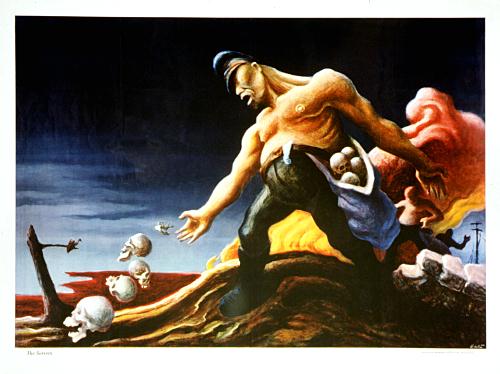
The Sowers by Thomas Hart Benton, 1942. One of a series of eight
paintings in which Benton portrayed the barbarity of fascism.
Photo credit: National Archives and Records Administration.
Online
Source
|
| 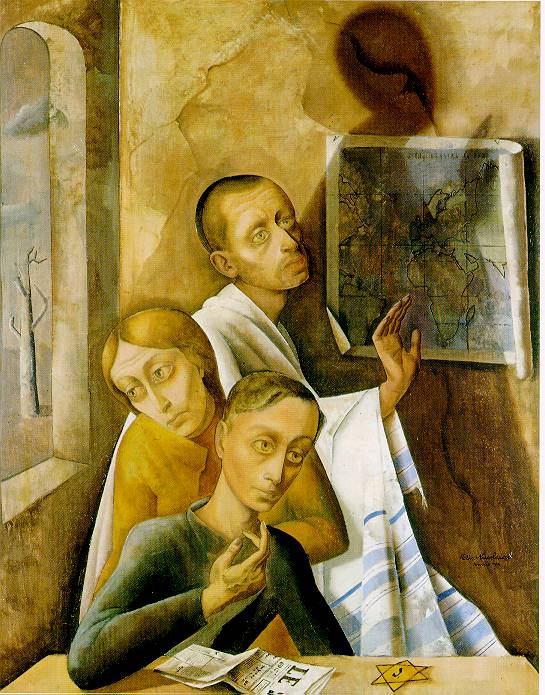
Threesome (1944), by Felix Nussbaum (1904-1944). Oil/Canvas,
100x80cm
In Threesome, painted in January 1944, Nussbaum portrays himself as a pious Jew
in
hiding with his wife Felka and his son Jaqui. The triangular composition is reminiscent
of renaissance sacral art. The painter identifies himself fully with the religion to which
he
was thrown back as a result of the persecution by National Socialism, whereas his
wife merely endures the situation. Felix Nussbaum describes here in one of his last
pictures
the situation of all those persecuted which lies somewhere between
fear of death and vague hope.
Online
Source
|
| 
Children as well as adults documented events of the Holocaust through art.
In this child's drawing, Jews are shown under armed guard, being
pushed into a van which will take them to deportation trains. Era: During WWII.
Online
Source
|
| 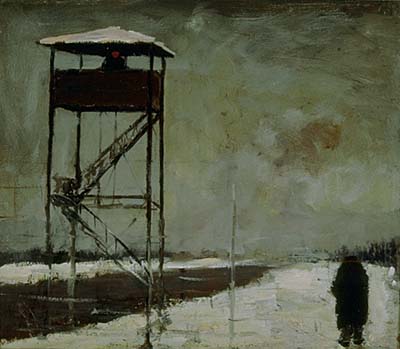
Laufen (undated), by Josef Nassy (1904-1976), a Black expatriate
of Jewish descent
who was one of 2,000 internees with American passports held prisoner in
Germany during WWII.
Online Source
|
| 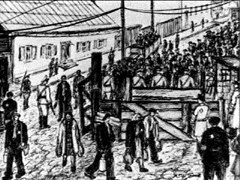
1942. Esther Lurie used ink on cardboard to draw this
scene. She described here new deportees arriving
in the ghetto, carrying bundles of their meager
possessions and scrutinized by armed guards.
Online
Source
|
| 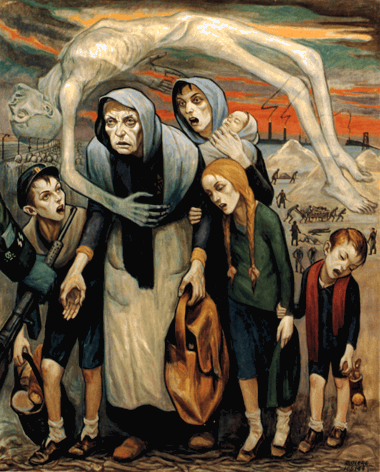
Unable to Work by David Olère. 131x162 cm, A Living Memorial to
the Holocaust,
New York. Inability to work was often an immediate death sentence. In the background
of this painting, smoke rises from the crematorium to form the SS insignia.
David Olère: L'Oeil du Témoin/The Eyes of a Witness. New York: The Beate
Klarsfeld
Foundation, 1989, p. 31. Reprinted with permission from the Beate Klarsfeld
Foundation.
Online
Source
|
| 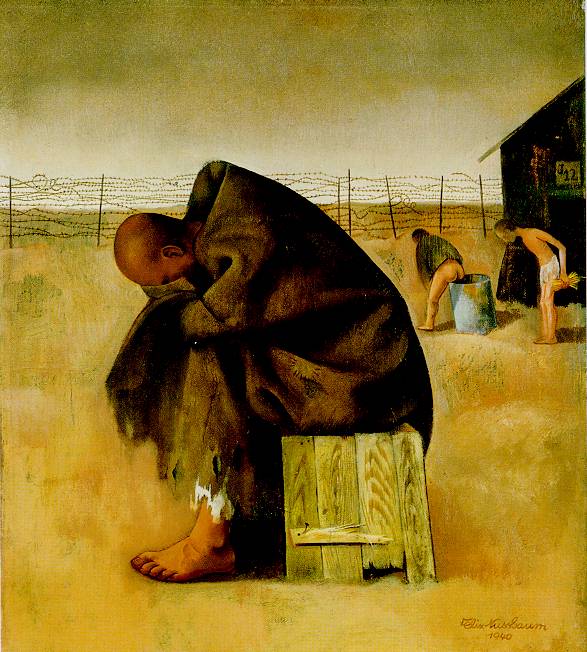
By Felix Nussbaum. Born in 1904, he died at Auschwitz in 1944.
Online
Source
|
| 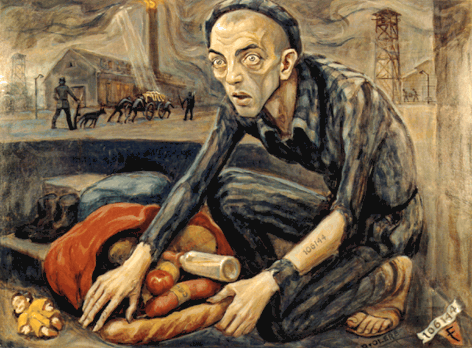
The Food of the Dead for the Living by David Olère. 102x76 cm, A
Living
Memorial to the Holocaust, New York. Olère collects food, abandoned near
the undressing rooms of crematorium III at Birkenau, so he can throw it over
the fence to the prisoners at the women's camp. David Olère: L'Oeil du Témoin/
The Eyes of a Witness. New York: The Beate Klarsfeld Foundation, 1989, p.86.
Reprinted with permission from the Beate Klarsfeld Foundation.
Online
Source
|
| 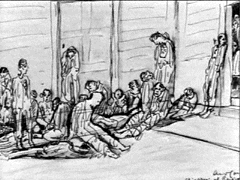
Jews in the Hospital, by Aldo Carpi, 1945. This drawing
depicts the camp hospital. Sick prisoners were brought
here, but there was little the medical staff could do for
them. Most patients died within a short time.
Online
Source
|
| 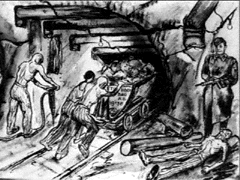
"Forced Labor - Building a Tunnel" by David Olere, 1945.
Given severely limited food rations, prisoners
were exploited in hard labor, such as the digging
of a tunnel, depicted here in watercolor and
charcoal. Those unable to work were killed.
Online
Source
|
| 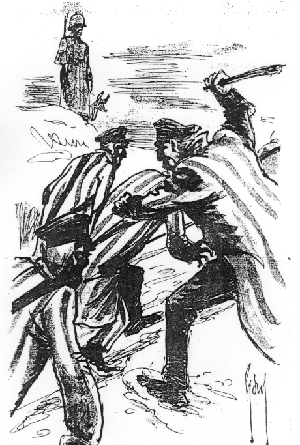
Kommando, by Fernand Van Horen. Van Horen was a Belgian survivor
of Esterwegen and Flossenburg concentration camps.
Online
Source
|
| 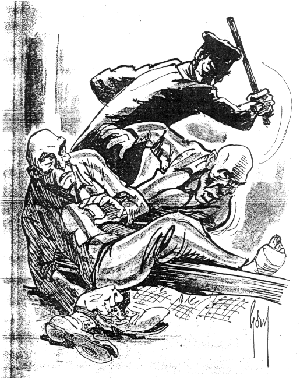
Normal Life in Flossenburg, by Fernand Van Horen
Online
Source
|
| 
Many prisoners in concentration camps portrayed
the events of their lives through art. This drawing
depicts hundreds of Jews marching under Nazi
guard to the gas chamber at Auschwitz.
Online
Source
|
| 
Gassing by David Olère. 131x162 cm, A Living Memorial to the
Holocaust, New York.
The container in the lower right is labeled Zyklon B. David Olère: L'Oeil du Témoin/
The Eyes of a Witness. New York: The Beate Klarsfeld Foundation, 1989, p. 54.
Reprinted with permission from the Beate Klarsfeld Foundation.
Online
Source
|
| 
Memorial Art at Auschwitz--"Zyclon B cans"
Photo Credit: Florida Center for Instructional Technology
Online
Source
|
| 
Memorial Art at Auschwitz--Temporary gas chamber used during 1941 and 1942.
Photo Credit: Florida Center for Instructional Technology
Online
Source
|
| 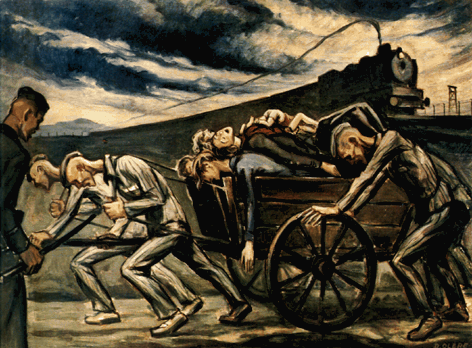
Arrival of a Convoy by David Olère. 65x50 cm, A Living Memorial
to the Holocaust,
New York. A new convoy arrives in the background as inmates struggle with a cart
carrying away cadavers from a previous convoy. David Olère: L'Oeil du Témoin/
The Eyes of a Witness. New York: The Beate Klarsfeld Foundation, 1989, p. 13.
Reprinted with permission from the Beate Klarsfeld Foundation.
Online
Source
|
| 
Memorial Art at Auschwitz--One small section of the "mountain" of
shoes on display at the camp.
Photo Credit: Florida Center for Instructional Technology
Online
Source
|
| 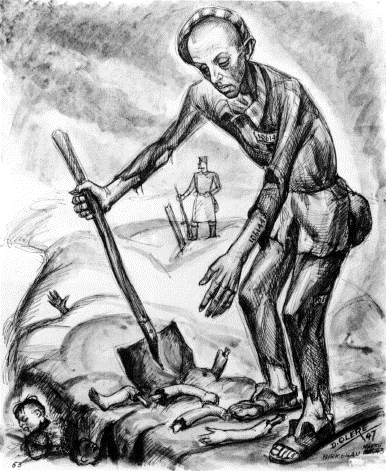
David Olère Burying the Remains of Children by David Olère.
32x40 cm, Olère Family.
Olère's first assignment at Auschwitz was as a grave digger of bunker 2. His prisoner
number,
106144, is seen both on his shirt and as a tattoo on his left arm. David Olère:
L'Oeil du Témoin/
The Eyes of a Witness. New York: The Beate Klarsfeld Foundation, 1989, p. 38.
Reprinted with permission from the Beate Klarsfeld Foundation.
Online
Source
|
| 
Yehuda Bacon (b. 1929), In Memory of the Czech Transport to the Gas
Chambers,
1945, Charcoal on paper. A short time following his liberation from Auschwitz,
the sixteen-year-old Bacon drew this portrait of his father who perished in the
death camp. Like a necromancer, Bacon conjures up the thin, exhausted face
and blazing eyes of his father, the disembodied face ascending from the smoke. The image
of the father whose life was ended in the furnaces of Auschwitz is reconstructed by
the son who still remembers the father he was recently separated from. In the lower
section of the drawing, where we would expect to see his father's body, we detect
the crematoria and a body hanging off the barbed wire fence which surrounded the camp.
In the right-hand corner, the artist has added the date and time: 10.VII.44, 22:00 -
marking the exact moment when his father perished.
Online Source
|
| 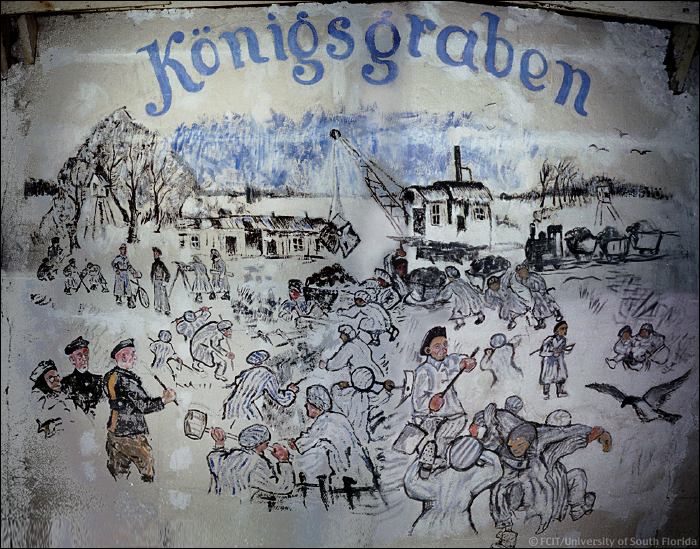
Birkenau. Painting of Königsgraben from the ceiling of the penal company
barrack at Birkenau.
Photo Credit: Florida Center for Instructional Technology
Online
Source
|
| 
Warsaw Uprising Memorial. Detail of insurgent unit.
Photo Credit: Florida Center for Instructional Technology
Online
Source
|
| 
Holocaust memorial park in old Jewish quarter of Berlin.
Photo Credit: Florida Center for Instructional Technology
Online
Source
|
| 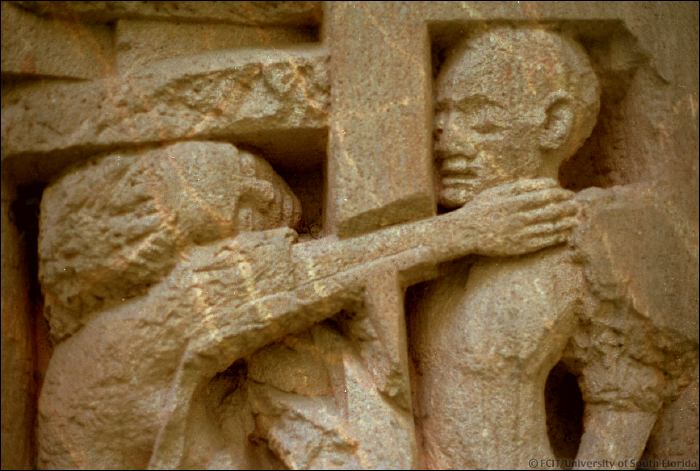
Detail, Holocaust memorial park in old
Jewish quarter of Berlin.
Photo Credit: Florida Center for Instructional Technology
Online
Source
|
| 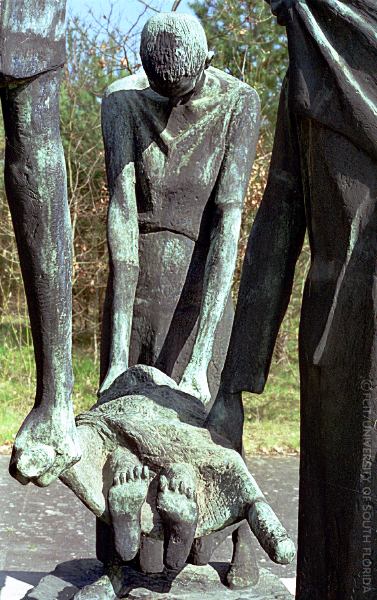
Muttergruppe by Fritz Cremer (1906-1993). Bronze.
Located on Dorfstraße on the way to Ravensbrück Camp.
Photo credit: Florida Center for Instructional Technology
Online
Source
|
| 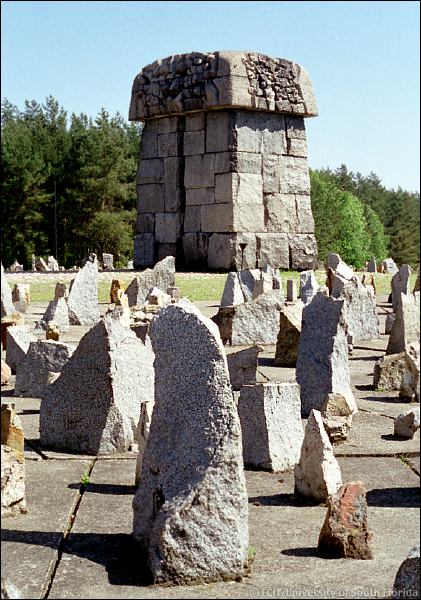
Treblinka. Center monument side view.
Photo Credit: Florida Center for Instructional Technology
Online
Source
|
| 
Treblinka. Field of 17,000 stones, representing the lost Jewish
communities.
Photo credit: Florida Center for Instructional Technology.
Online
Source
|
| 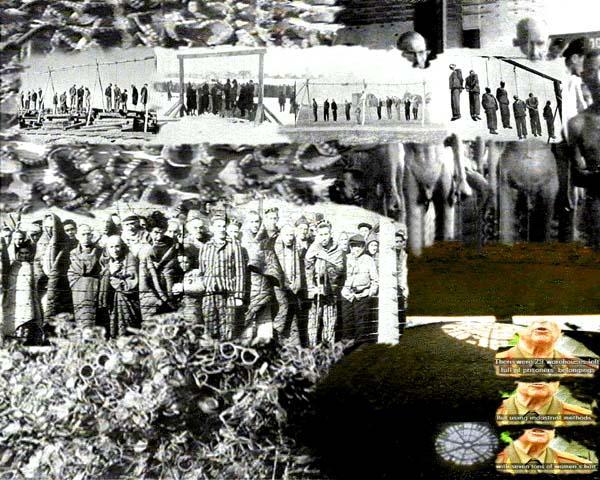
Haunting Memory 3. From A Triptych by R. A. Beecroft MA, The
Nottingham Trent University.
Here are lines of hanging people overlain on the pile of false teeth. Here is a line
of
survivors standing, staring between the teeth and a mound of spectacles. Here is a pile of
ashes of industrially murdered people. There is the mouth of a Russian, talking about what
they
discovered: seven tons of women's hair. Survival was such a matter of chance;
it is literally dreadful that survivors should have felt guilty.
Online Source
|
| 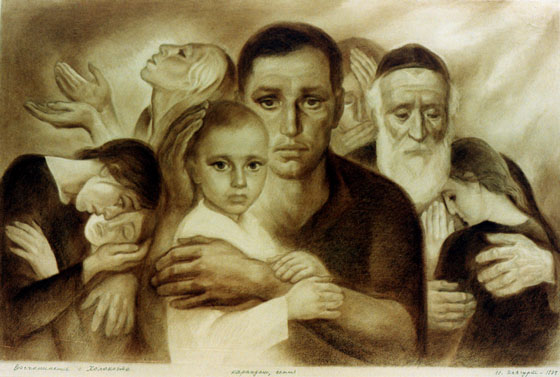
In Memory of the Holocaust by Josef Elgurt, 1994, sepia-drawing
(71 x 46 cm). Elgurt was born in
Kishinev, Moldova. He was imprisoned in Nazi ghettos in Moldova, Ukraine, and Romania. The
original
is on permanent loan to the Jewish Museum of Riga. ©1994 Josef Elgurt. Used with
permission of the artist.
Online
Source
|
| 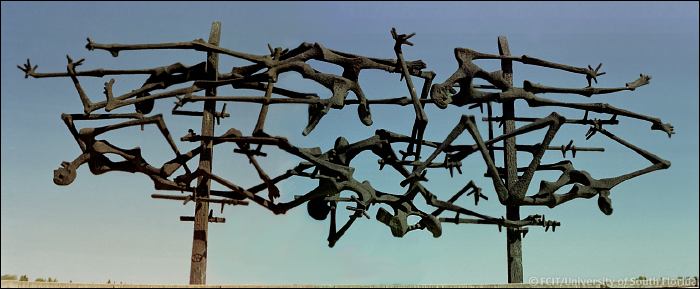
A view of the International monument by Yugoslav sculptor Glid Nandor,
1968.
Nandor spent time in a forced labor camp during the war and later fought with
the Yugoslav partisans. Other memorials by Nandor may be seen at the Mauthausen camp
and in Subotica.
Photo credit: Florida Center for Instructional Technology.
Online
Source
|
